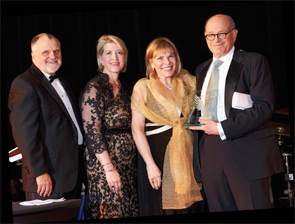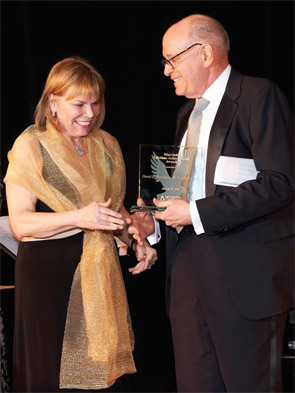
The Arthritis Foundation (AF) Mid Atlantic Region recently honored ACR President David G. Borenstein, MD, with the Marriott Lifetime Achievement Award for his work with the foundation and his dedication to the fight against arthritis.
“Dr. Borenstein represents all that’s very good about physicians,” says AF’s Mid Atlantic Region Chief Strategy Officer Calaneet Balas, noting that selecting him was “a slam dunk.”
The selection committee looks for people or organizations committed to changing the welfare of people with arthritis. Dr. Borenstein is deeply committed to his patients regardless of his other roles as a leader on the national stage, says Balas. “I think he’s always trying to make sure that both the patient and the physician are being thought of when there are changes in healthcare, and that’s a pretty unique person. Most people fall on one side or the other in their vision.”
Rheumatologist Patience H. White, MD, a professor of medicine and pediatrics at George Washington University School of Medicine in Washington, D.C., and the AF’s vice president of public health, describes Dr. Borenstein, a longtime friend and colleague, as a convincing advocate for rheumatologists. He is a good communicator and an outstanding physician and author at the top of his game. “He’s approachable. He’s articulate and warm and funny—a great sense of humor,” says Dr. White. “And that’s a great combination. He gets people’s attention. Last but not least, he is a fabulous father of three very accomplished young women … and has a wonderful wife who is a lawyer. They are just a wonderful family.”
Dr. Borenstein maintains a practice in Washington, D.C. and continues to be involved in patient advocacy and public policy in his current role as ACR president. He is also clinical professor of rheumatology at George Washington University Medical Center.
Long Relationship with AF
Dr. Borenstein’s association with the AF reaches back more than 30 years. The foundation helped him early on to develop his areas of research, awarding him a grant in 1978 to study infectious arthritis at George Washington University Medical Center, he says. He subsequently joined AF’s medical advisory committee and later served as a board member and vice president of the local chapter from 2006 to 2007. He left that post when he became the ACR treasurer.
Having worked on the ACR’s government affairs committee, Dr. Borenstein says efforts to inform politicians about arthritis is a constant process because legislators come and go but the need for arthritis awareness never changes. Patient involvement empowers patient and physician alike and is key to getting the message heard by those who can make a difference, he says.
“It makes it much easier as an advocate for them as their physician to say that the people with this problem are actively engaged and interested in trying to make their lives better,” says Dr. Borenstein.
Focus on Patients
“Never give up on a patient” is the philosophy Dr. Borenstein lives by, and he says that some patients even return after a decade of absence with new problems, believing that he fixed them once and he can do it again. He jokes that, “the staff knows they should not put my old files too, too far away.”
Somewhat of a doodler, Dr. Borenstein often draws pictures to help patients understand how to handle their back pain. The inspiration for his first book for a lay audience came from one of those patients who suggested he “write it down.”
Heal Your Back: Your Complete Prescription for Preventing, Treating, And Eliminating Back Pain (Rowman & Littlefield Publishers, Inc., 2011), released earlier this year, teaches patients about their back pain and how to manage it. It is Dr. Borenstein’s second book written for the general public; he also authored three medical textbooks for doctors on low back and neck pain.

While no single back-pain therapy works for everyone, research tells us that the musculoskeletal system heals on the move, says Dr. Borenstein. He believes in the necessity of exercise, and in his spare time he likes to play squash. Besides being fun, the racquet sport aptly illustrates a message he repeats often to his patients with back pain: Our bodies were made to move.
“We’re not made to be sitting on our behinds so much,” he says, echoing what he frequently reminds patients. “I say, ‘Get up. Get up!’ That’s what I tell them.”
Magnetism of Medicine
On his way to becoming a chemist as an undergraduate, Dr. Borenstein changed courses after a brief but enlightening chat with his older brother, also a doctor. “My older brother wanted to be a doctor as long as I knew him … and because of that I didn’t want to be a doctor,” he explains.
A simple comment from his older brother freed him of that notion and redirected him toward a gratifying career in medicine. “He said, ‘Get over it. You could be a doctor too,’ ” Dr. Borenstein recalls.
He obtained his undergraduate degree from Columbia University and completed medical school and fellowship training at Johns Hopkins University School of Medicine. He says he chose the field of rheumatology because it posed intriguing challenges for him and offered opportunities to make a contribution.
Dr. Borenstein says that it’s an honor to receive the AF Award, which was recently presented to him at an Arts for Arthritis Gala award ceremony. During an acceptance speech, he paid tribute to his professors, who showed him how to be a compassionate physician while constantly testing conventional wisdom.
“I saw that they took care of people for long periods of time … that meant you were willing to take care of people with chronic illnesses, with all the ups and downs associated with it. At the same time, they also pointed out to me the fact that we really didn’t know much of the things involved with our subspecialty. There were many unanswered questions,” says Dr. Borenstein.
A relationship early in his career with orthopedic surgeon Sam W. Wiesel, MD, led Dr. Borenstein to his lifelong pursuit of better low-back pain treatments and the desire to write about what he’s learned along the way. Dr. Wiesel was interested in spinal disease and, wanting to work with a rheumatologist, began sending patients to Dr. Borenstein.
“I sort of became self taught,” Dr. Borenstein says. “I read pretty much everything that there was on the topic and started formulating my own ideas about it.”
Helping people and their doctors better understand back pain is important because back pain strikes so many people throughout their lifetimes, he says. “I’m constantly seeing patients who have difficulties with spinal problems, low back or neck. It keeps me busy on a daily basis.”
Despite a busy work schedule, Dr. Borenstein says he sneaks to a movie now and then with his wife and—taking his own advice to heart—still plays squash three times a week for fun and to keep energized. “I started playing in medical school and have not stopped,” he says.
Catherine Kolonko is a medical writer based in California.
